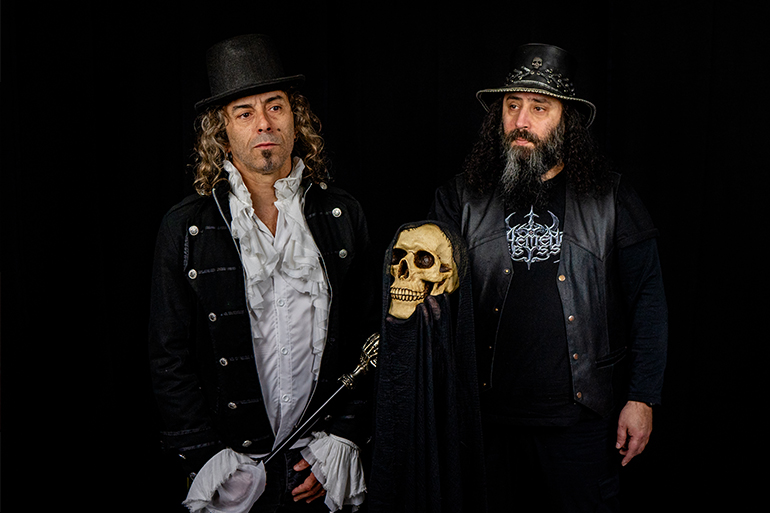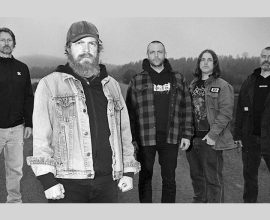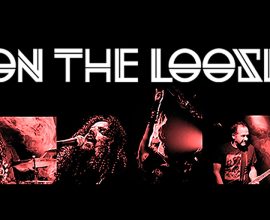“No sin. No redemption. Only indulgence”, Nekromatics about ‘Place of Indulgence’
With the release of Place of Indulgence, the duo Nekromatics invites the listener to cross a portal of shadow, desire, and liberation. The album is more than just a collection of tracks — it is a sonic manifesto of indulgence, a conscious rejection of guilt and the penance imposed by traditional morality. Through abrasive riffs, cinematic orchestrations, and soundscapes of urban decay, the record builds a universe where beauty and horror coexist, and where individual freedom is celebrated as an act of spiritual rebellion.
By Sandra Pinto
In this interview, Melek Taus and Melkor delve into the origins and concepts behind Place of Indulgence — from the meaning of the title and the creation of the tracks to the role of the studio, literary influences, and the occult imagery that permeates their work. The result is a dense and revealing conversation that explores not only the musical construction but also the philosophy behind the world of Nekromatics — a place where excess is virtue, darkness is liberation, and every song is a ritual in itself.
What does the title “Place of Indulgence” represent, and how does it reflect the overall concept of the album?
The title Place of Indulgence is literal and deliberate: it celebrates indulgence instead of abstinence. For us it means the uncompromising liberty of the individual, the right to feel, desire, and act without ritual self-punishment or moral self-censure for thinking or wanting what society says we shouldn’t. We do not recognise “sin” in the traditional sense, and therefore we do not accept the notion of remission as a moral or spiritual solution.
Musically and thematically the album follows that idea throughout. Place of Indulgence is a ritual for the unapologetic self, an ode to breaking dogma, whether religious, political, or cultural. The songs map a decaying, neon cityscape where beauty and horror coexist, and where the characters refuse to hide behind guilt or false virtue. At the same time, the record is not anarchy without limits: it defends freedom with responsibility, the idea that your liberty ends where the next person’s begins. That tension, ecstatic transgression versus the ethics of coexistence, is the conceptual backbone of the whole record.
In short, the album is a sonic manifesto for free thought: a dark, urban hymn to desire, excess, and personal sovereignty, written from a place that refuses confession and celebrates consequence.
Which track do you feel best represents the essence of the album, and why?
I would say Overkill Boulevard best represents the essence of the album. It was the track that actually shaped the whole record and defined our musical direction. In a way, Overkill was the spark that made us understand what Nekromatics truly sounds like.
It carries all the elements that became essential to our identity, the fusion of aggressive riffs, symphonic layers, and that dark, urban decay atmosphere that runs through the entire album. Lyrically, it’s also a perfect mirror of the album’s spirit: a journey through a city of sin, chaos and freedom, where indulgence replaces guilt and the only law is desire.
It’s decadent, cinematic, and unapologetic, the exact place where our concept of “indulgence over abstinence” came to life for the first time.
There’s a clear theme of excess and darkness throughout the album. Was this inspired by personal experiences, literature, or something else entirely?
The lyrical side of Place of Indulgence is mainly inspired by literature and horror cinema, there’s no personal experience being told in the album. We wanted to build a world rather than a diary, something that draws from gothic fiction, psychological horror, and the darker side of urban decay. Writers like Poe, Baudelaire, and Lovecraft, and even modern filmmakers, inspired that sense of beauty within destruction, the fascination with madness, guilt, and desire. It’s about exploring human impulses in their rawest form, but through allegory and atmosphere, not confession. We see Place of Indulgence as a movie for the mind, each track a different scene from a decadent, dreamlike city where horror, lust, and introspection coexist. The excess and darkness are just reflections of what lies beneath civilized masks, the things people fear to acknowledge but secretly understand.
Can you describe the journey you want listeners to go through when experiencing this album from beginning to end?
We want the listener to step inside this ultra-sonic train and enjoy the oppressive darkness of a forty-minute journey. Place of Indulgence was designed to feel like a descent, not necessarily into evil, but into liberation through chaos. Each song is a different stop along that line, from the neon streets of Overkill Boulevard to the burning ruins of Necropolis Ablaze.
It’s not meant to be comfortable. The atmosphere grows denser with every track, shifting between aggression, melancholy, and eerie beauty. By the end, we want you to feel both drained and strangely renewed, as if you’ve walked through decay and come out cleaner on the other side. In the end, the journey is about confrontation: facing the shadows within and realizing they’ve always been part of you.
“Love, Murder and Mental Issues” is an intense and evocative title. What’s the story behind that track?
There is indeed a story behind Love, Murder and Mental Issues, a bizarre love story intertwined with severe psychological and psychopathic disorders. But that’s as much as we’re willing to reveal, mainly to avoid any possible misunderstandings or unnecessary controversy.
The song is inspired by real events, but it never mentions any specific person or situation, which leaves the narrative completely open to interpretation. That’s intentional, we wanted the lyrics to feel like fragments from a disturbed mind, where love and insanity become indistinguishable. Musically, it also mirrors that descent, starting in a more fragile, acoustic tone and then collapsing into chaos. It’s one of the most human tracks on the album, precisely because it’s so uncomfortable.
How did you approach the orchestration process to ensure the symphonic elements enhanced, rather than overwhelmed, the extreme metal core?
It was actually a very natural process, because that was the core idea from the beginning, to build a Black/Death project rooted in a strong symphonic foundation. We didn’t add orchestration as decoration; it was part of the DNA from day one.
We wanted something fast, aggressive, and melodic, but with the grandeur and cinematic depth that the symphonic element brings. The challenge was balance, making sure the orchestra served the song rather than drowning it. Every string, brass, or choir line had to enhance the intensity, not soften it. The orchestral arrangements became another weapon in the arsenal, amplifying the chaos, emotion, and atmosphere without stealing space from the guitars or vocals. In the end, it’s not about “metal plus orchestra”, it’s one entity, one organism breathing together.
What role did Studios13 play in shaping the album’s dark atmosphere and sonic identity?
Studios13 played a crucial role in shaping the dark atmosphere and overall sonic identity of Place of Indulgence. It’s the creative domain of Melkor, where all recording, orchestration, production, and mixing take place. The studio has a very distinct aura, it’s where the Nekromatics sound gains its density, its texture, and that oppressive sense of space we wanted the listener to feel.
However, the genesis of the album begins elsewhere, in the mind and home of Melek Taus, where every composition is conceived and sculpted long before entering the studio. That’s where the riffs, structures, and initial concepts take shape, and from there, the songs evolve into full orchestrated entities inside Studios13. So while Studios13 is absolutely essential in defining the sound, turning ideas into something tangible and powerful, the heart of the process still starts at the source, where inspiration meets chaos and the music first takes form.
Which elements of classical or cinematic music influenced your symphonic arrangements?
In the case of Melek Taus, the biggest influences come from the great cinematic orchestrations, the kind you hear in Star Wars, Indiana Jones, or the classic scores from Psycho and other Hitchcock masterpieces, as well as the composers who followed that lineage. There’s something timeless about the tension, grandeur, and emotional weight of those arrangements, they create landscapes as vivid as any metal riff. That cinematic sense of drama heavily shaped the way the orchestral layers were built in Place of Indulgence.
For Melkor, the inspiration comes from both horror cinema and certain bands known for their intense, almost film-like atmospheres, groups that use symphonic elements not as ornamentation but as emotional weapons. The goal was to merge those worlds: the epic storytelling of classical film music with the aggression and darkness of extreme metal.
In the end, our symphonic approach is less about imitation and more about translation, turning cinematic emotion into blackened sound.
How did you achieve the balance between brutality and beauty across the album?
For Melek Taus, achieving the balance between brutality and beauty was all about careful attention and restraint. He focused on blending the two elements without ever letting one overpower the other, remaining fully concentrated throughout the process to stay true to the original concept. Every riff, orchestration, and melody was crafted with that equilibrium in mind.
For Melkor, the challenge was in mixing all the tracks in a way that preserved clarity while highlighting the emotion Melek Taus felt for each part. The goal was to ensure that both the aggression and the cinematic, melodic elements were perceptible and complementary. It was a meticulous, labor-intensive process, but we aimed to deliver the best possible result with the resources and tools we had, keeping the essence of the album intact.
Was there any moment during production where you felt the music was going too far—or not far enough?
Not really, we never felt the music was going too far or not far enough. Of course, there were moments of doubt, steps backward, and periods of experimentation, but throughout the process, the vision remained clear. Every choice, every adjustment, and every experiment felt like a necessary part of shaping the album, and nothing ever strayed from the essence we wanted to capture. In the end, even the uncertainties contributed to the intensity and cohesion of Place of Indulgence.
The name Nekromatics suggests forbidden knowledge and resurrection — what deeper meaning does it hold for you personally?
For us, Nekromatics embodies the fascination and reverence we feel for the occult, ancient wisdom, and hidden knowledge. It’s about exploring the mysteries of life, death, and what may lie beyond, the things most people fear to consider, yet which hold profound insight. The name also reflects our curiosity for the forbidden and the transformative power of knowledge that exists outside conventional understanding.
In essence, Nekromatics is both a symbol and a practice: an embrace of the unknown, a journey through shadow and ritual, and a reminder that true understanding often lies where light does not reach.
You describe each song as a ritual — how important is the spiritual or occult dimension in your music?
For us, the spiritual and occult dimension is absolutely essential, it functions almost as a mandatory complement to the sound we aim to create. Each track is designed like the perfect soundtrack for a specific ritual, a narrative that matches the intensity and atmosphere of the music itself. Honestly, it’s hard to separate these themes from Black or Death Metal. Without this union of sound and ritual, the album simply wouldn’t be the same. The occult and spiritual aspects aren’t just decoration; they are a fundamental part of the music’s identity and its emotional impact.
What inspired the creation of the character or world behind songs like “Necropolis Ablaze” or “Dead End Paradise”?
The characters and worlds behind songs like Necropolis Ablaze and Dead End Paradise were inspired by our fascination with urban decay, chaos, and the darker side of human existence. We imagined cities that are almost alive in their horror, streets burning, neon lights flickering, and shadows that move on their own. These places are more than settings; they’re characters themselves, reflecting the intensity, excess, and moral ambiguity of the inhabitants.
In Necropolis Ablaze, the city becomes a crucible of fire and death, where ghosts of the past are forced to rise, and destruction is both spectacle and inevitability. Dead End Paradise, on the other hand, explores the claustrophobic, cyclical nature of urban vice, a neon-lit maze where corruption, desire, and decay are constant companions.
Ultimately, these worlds are allegories for extremes of human experience, indulgence, obsession, and the fine line between freedom and chaos, designed to immerse the listener in the same oppressive, cinematic atmosphere that shapes the album as a whole.
Your lyrics explore decay, madness, and desire. Are these metaphors, or do they reflect real views on the human condition?
Our lyrics are a blend of both metaphor and observation. Themes like decay, madness, and desire are amplified and dramatized to create an immersive, almost ritualistic experience, but they’re rooted in real reflections on the human condition.
We see these elements as natural extremes of life, the way obsession, fear, and longing shape choices and societies. By magnifying them in music and imagery, we’re not simply telling stories; we’re exploring the raw forces that govern behavior, the hidden impulses people often ignore or suppress. The songs become mirrors, showing both the beauty and the horror that coexist within human nature.
Do you see your music as a form of catharsis, rebellion, or something else entirely?
We see our music as a mixture of catharsis, rebellion, and ritualistic exploration. It’s cathartic because it channels extreme emotions, aggression, desire, fear, into something tangible and structured. At the same time, it’s a form of rebellion against dogma, expectation, and limitation, both musically and thematically.
But beyond that, it’s also a space for reflection and immersion, a ritual for the listener, where darkness, excess, and beauty coexist. The goal isn’t just to shock or entertain; it’s to provoke thought, stir emotions, and confront the parts of human nature most people tend to suppress. In that sense, every track is a ceremony, and the album itself a guided journey through the extremes of mind and society.
What does it mean for you to be part of the extreme metal underground in 2025?
Being part of the extreme metal underground in 2025 means carrying forward a legacy while shaping it with our own vision. It’s about independence, integrity, and intensity, creating music that isn’t dictated by trends, algorithms, or commercial expectation.
The underground is where experimentation thrives, where you can merge symphonic grandeur with black/death aggression without compromise. For us, it’s a community and a mindset: one that values authenticity, devotion, and pushing boundaries. In 2025, it also means connecting globally while staying true to a local, intimate identity, preserving the raw, uncompromising spirit of extreme metal in a world that often favors the safe and the predictable.
Do you feel the black/death metal scene is evolving in the right direction creatively?
Yes and no. On one hand, the black/death metal scene continues to push boundaries, blending genres, experimenting with orchestration, atmosphere, and even production techniques. There’s a lot of creativity happening, and it’s exciting to see bands willing to take risks rather than repeat old formulas.
On the other hand, there’s still a tendency in some corners to prioritize style over substance, or to follow trends rather than challenge them. For us, the ideal evolution is one that preserves the intensity and authenticity of extreme metal while encouraging innovation and personal expression. Ultimately, it’s about keeping the spirit alive, fierce, uncompromising, and willing to explore new sonic and conceptual territories.
How has the reception been so far from early listeners, and what feedback has stood out most?
The reception so far has been overwhelmingly positive, which has been incredibly encouraging for us. Early listeners have really connected with the atmosphere, the orchestration, and the intensity of Place of Indulgence.
What has stood out most is how people appreciate the balance between brutality and melody, and the way the symphonic elements enhance rather than overpower the core metal sound. We’ve received messages from fans saying it’s dark, cinematic, and yet personal, a record they can lose themselves in, track by track. It’s extremely rewarding to see that the vision we had in mind resonates so strongly with listeners, both new and experienced in the extreme metal underground.
Are there plans for live performances or rituals to accompany the album’s release?
Yes, we have plans for 2026. The band is now complete, and we want to perform as much as possible under the right conditions. Until then, we’re focused on rehearsing extensively and perfecting the synergy between the members of Nekromatics.
We see live performances as an extension of the album itself, almost ritualistic experiences where the atmosphere of Place of Indulgence can be fully realized. Each show will be about immersing the audience in the dark, cinematic world of the music, bringing both intensity and precision to every performance. Our goal is to make each concert a journey, as compelling and uncompromising as the album itself.
If you could summon one reaction or emotion from your listeners after hearing Place of Indulgence, what would it be?
If there’s one reaction we hope to summon in our listeners after experiencing Place of Indulgence, it’s a profound sense of immersion, a feeling that they’ve been transported into a world that is at once dark, intoxicating, and strangely liberating. We want people to feel the weight of the atmosphere, the tension of the neon-lit streets, the oppressive beauty of chaos, and the thrill of confronting impulses and desires that are usually hidden or suppressed.
It’s not just about shock or awe; it’s about engagement with the music on multiple levels, intellectually, emotionally, and even spiritually. We want them to sense the balance between brutality and beauty, the careful orchestration, and the stories woven into every track. Ideally, listeners will feel both exhilarated and unsettled, as if they’ve walked through shadows and fire and come out with a deeper awareness of themselves and the extremes of human nature.
Ultimately, the album is a ritual in sound, a journey through decadence, desire, and liberation, and the reaction we hope to inspire is one of complete surrender to that experience, even if only for the forty minutes the record lasts. If they close the album feeling charged, thoughtful, and haunted in the most exhilarating way, then we’ve succeeded.





